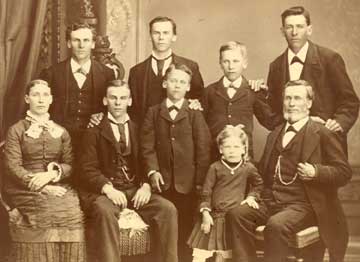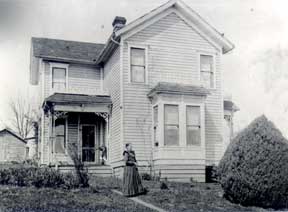 |
Previous Issues |
| Cedar Mill Community Website |
|
| About Cedar Mill News |
|
||||||
| Volume 7, Issue 7 | July 2009 |
|||||
History in The News
|
 |
| John Quincy Adams Young and his family, c. 1900 photo courtesy of Bernie Young |
Their supplies being depleted, the Youngs decided to stay at the mission and assist Dr. Whitman in building a gristmill nearby. Only weeks later disaster struck. The infamous Whitman Massacre took place in late November. Thirteen people were killed outright, including Whitman and his wife, the former dismembered and mangled beyond recognition.
The tragedy struck the Youngs as well. James Young was killed while driving a wagon from the mission to the gristmill. John Quincy Adams, his brother Daniel and his parents were unhurt. Still, the Cayuse held them and some fifty others prisoner, until Peter Skene Ogden of the Hudson’s Bay Company at Fort Vancouver ransomed the captives a month later.
The gruesome Whitman Massacre was one of the cataclysmic events of the period. When news of it reached Washington, it helped to usher in the establishment of the more formal Oregon Territory a year later.
It is difficult for us to imagine what must have gone through the minds of the Youngs, who were looking for a promising future, only to be faced with exhaustion, death of one of theirs, loss of all their possessions, and then imprisonment at the hands of the Cayuse.
With the other freed settlers, they reached Fort Walla Walla on December 31, 1847. They left the next morning in three large boats for Fort Vancouver. JQA Young said in his memoir, “Think of this, going down the Columbia in mid-winter in open boats, with only blankets and our scanty clothing on our backs, and a very few personal possessions. All our cattle, oxen, and wagons were confiscated or, in other words, stolen from us by the five Indians in the camp.”*
They stayed at Fort Vancouver for a few days, but soon afterwards boarded a barge to Oregon City. Elam, Daniel and JQA worked odd jobs to see the family through the winter, and then in May 1848 they moved to a small house in the Tualatin Valley to work for Walter Pomeroy.
A year later (1849) Irene and Elam Young settled on two Donation Land Claim plots totaling 642 acres around present-day Orenco. (Elam Young Parkway runs through it.) From all we can tell, JQA continued working the farm with his father and brother Daniel for the next few years. His father died in 1855, at age 67. Their mother Irene died in 1865 at age 74.
In 1856 John Q.A. Young married a neighbor, Elizabeth Constable, one of five children orphaned on the Oregon Trail, who were brought to the Oregon Territory to live with their late father’s nephew. John and Elizabeth had a total of 11 children, three of whom died young. Elizabeth was a respected midwife, seeing to the births of at least fifty babies in the area.
JQA and Daniel and their families continued living on their parents’ farm until they sold it. Daniel’s first wife died and is buried in Union Cemetery in Cedar Mill, he later moved to the Goldendale Washington area.
 |
| Elizabeth Young in front of the second family home, date unknown. Photo courtesy of Bernie Young. |
In 1869 John Q.A. Young formed a partnership with William Everson, who had crossed the plains in the same wagon train as the Young family. They bought the “Jones Lumber Company” mill and 160 acres of timber from Justus Jones and his family, who had settled the original Land Claim on the property. We believe that the small house we today refer as the JQA Young House was built that same year. It became the home of the Young family, by now including five children.
By 1874 JQA Young had sold his interest in the sawmill and purchased 280 acres of land across the Cornell Road, where he built a much finer and bigger house in 1884. That house no longer exists—apartments now occupy the site.
Young converted the old house into a small general store. He petitioned the US government for a Post Office, proposing the name “Cedar Mill.” In 1874 he received his appointment as postmaster for the area. He operated his small Post Office from the original house until 1882, when George Reeves took over the position and ran the Post Office from his General Store at Cornell and Barnes.
John Quincy Adams Young then devoted his energies to what he called the “noblest calling of man,” namely farming. In his later life, JQA Young was a respected member of the growing community. Aside from farming he was an active member of the Wesley Chapel, the Oregon Historical Society, and the Oregon Pioneer Association. He was one of the founders of Leedy Grange, he served as a Justice of the Peace, and was a Washington County Commissioner from 1898 to 1902.
His eventful life ended in 1905. He died in his Cedar Mill home across from the earlier saltbox home. Elizabeth lived until 1934. They are buried in Union Cemetery off NW 143rd Avenue. Their graves are next to that of his parents Elam and Irene. (Union Cemetery, incidentally, is the resting-place of many of the early settlers of the area and well worth a visit.)
His role in naming the area and his service as first Postmaster marks the JQA Young House a valuable historical site for us today. It was named to the National Register of Historic Places on December 31, 2008. The house is now part of Tualatin Hills Park & Recreation District (see accompanying article about the Friends of the JQA Young House.)
*Compiled from various sources, including, “Life Sketches by John Q.A. Young, 1889,” extracted from the biography of John Quincy Adams Young, which was transcribed by his daughter Mabel Young McIlwain.
Published monthly by Cedar Mill Advertising & Design
Publisher/Editor:Virginia Bruce
503-629-5799
PO Box 91061
Portland, Oregon 97291